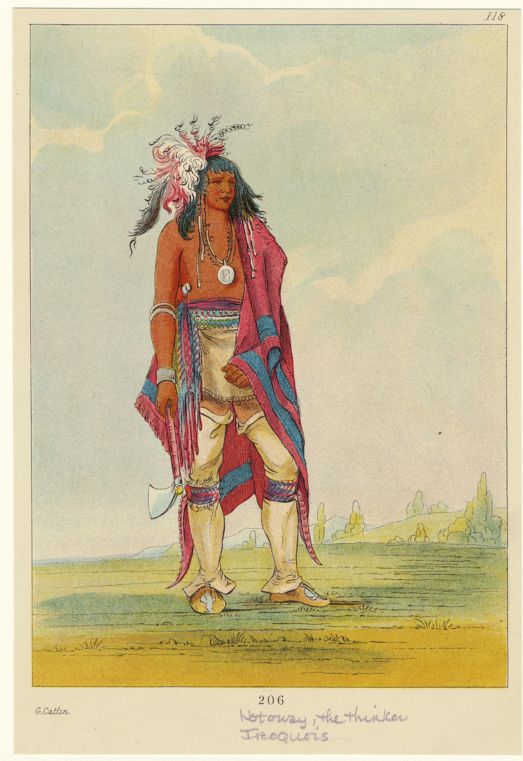Haudenosaunee (Iroquois)

The Iroquois, ![]() also known as the Five Nations or the Six Nations, and by the autonym Haudenosaunee
also known as the Five Nations or the Six Nations, and by the autonym Haudenosaunee ![]() meaning “people who are building the longhouse”), are an Iroquoian-speaking confederacy of Native Americans and First Nations peoples in northeast North America and Upstate New York. They were known during the colonial years to the French as the “Iroquois League”, and later as the “Iroquois Confederacy”. The English called them the “Five Nations”, including (east to west) the Mohawk, Oneida, Onondaga, Cayuga, and Seneca. After 1722, the Iroquoian-speaking Tuscarora from the southeast were accepted into the confederacy, which became known as the Six Nations.
meaning “people who are building the longhouse”), are an Iroquoian-speaking confederacy of Native Americans and First Nations peoples in northeast North America and Upstate New York. They were known during the colonial years to the French as the “Iroquois League”, and later as the “Iroquois Confederacy”. The English called them the “Five Nations”, including (east to west) the Mohawk, Oneida, Onondaga, Cayuga, and Seneca. After 1722, the Iroquoian-speaking Tuscarora from the southeast were accepted into the confederacy, which became known as the Six Nations.
The Confederacy is believed to have been founded by the Deganawidah Great Peacemaker at an unknown date estimated between 1450 and 1660, bringing together five distinct nations in the southern Great Lakes area into “The Great League of Peace”. came about as a result of the Great Law of Peace, composed by the Great Peacemaker, Hiawatha, and Jigonsaseh the Mother of Nations. For nearly 200 years, the Six Nations/Haudenosaunee Confederacy was a powerful factor in North American colonial policy, with some scholars arguing for the concept of the Middle Ground, in that European powers were used by the Iroquois just as much as the Europeans used them. At its peak around 1700, Iroquois power extended from what is today New York State, north into present-day Ontario and Quebec along the lower Great Lakes–upper St. Lawrence, and south on both sides of the Allegheny mountains into present-day Virginia and Kentucky and into the Ohio Valley. Each nation within this Iroquoian confederacy had a distinct language, territory, and function in the League.

The St. Lawrence Iroquoians, Wendat (Huron), Erie, and Susquehannock, all independent peoples known to the European colonists, also spoke Iroquoian languages. They are considered Iroquoian in a larger cultural sense, descended from the Proto-Iroquoian people and language. Historically, however, they were competitors and enemies of the Iroquois League nations.
In 2010, more than 45,000 enrolled Six Nations people lived in Canada, and over 81,000 in the United States.
Watch the video below and answer questions to check your understanding of the Iroquois people. Understanding an author and their history will help you to appreciate and better understand their story.
History Summarized: Iroquois Native Americans (YouTube)
References
Information on the Iroquois Confederacy from Wikimedia Foundation licensed under CC-BY-SA 4.0
Headphones by Molly Bramlet licensed under CC BY 3.0

